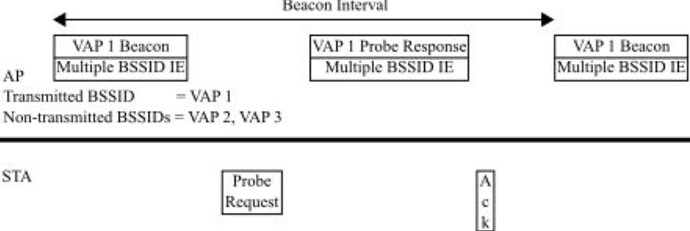Adding a new Virtual AP (VAP) adds management frame overhead as every VAP needs to beacon and respond to probe requests with a probe response.
-
Enhanced Multi-BSSID Advertisement (EMA) is a new feature in Wi-Fi 6 that enables multiple BSSID advertisement with lesser management frame overheads.
- EMA support is mandatory for Wi-Fi 6 client certification and EMA capability is advertised in the EMA Support field of Extended Capabilities Information Element (IE).
In EMA mode, one of more BSSIDs are assigned as transmitted BSSIDs and the remaining are defined as non-transmitted BSSIDs.
Beacons and probe responses are transmitted only for transmitted BSSIDs.
The capability IE of all non-transmitted BSSIDs is aggregated and packaged inside a Multiple BSSID IE which is included in transmitted BSSID’s beacon and probe response frames.
Each BSSID is assigned a BSSID Index using which the MAC address of a VAP can be computed as MAC address of Reference BSSID + BSSID Index.
One of the transmitted BSSID is assigned as reference BSSID whose BSSID Index is 0.
Therefore, the MAC addresses of all BSSIDs in a Multiple BSSID set share the first 48-n bits, where 2^n is the maximum number of configured BSSIDs.
The Multiple BSSID IE contains a non-transmitted BSSID profile subelement (BSSID Index, SSID and capability IEs) for each non-transmitted BSSID.
The capability IEs of a non-transmitted BSSID sharing the same values as that of the transmitted BSSID are skipped reducing overhead, and this is referred as “Inheritance of element values”.
The older generation Wi-Fi clients before Wi-Fi 6 cannot understand the Multiple BSSID IE and have trouble discovering the non-transmitted BSSIDs in EMA mode.
Therefore, EMA feature is typically not used in 2.4 GHz and 5 GHz deployments, while in 6 GHz band it can be used because only Wi-Fi 6 devices are present there.
Since the IE used is Multiple BSSID IE, some people in the industry also refer to this feature as Multiple BSSID feature, but the name given in the 802.11ax standard is EMA.
LinkedIn: ![]()
